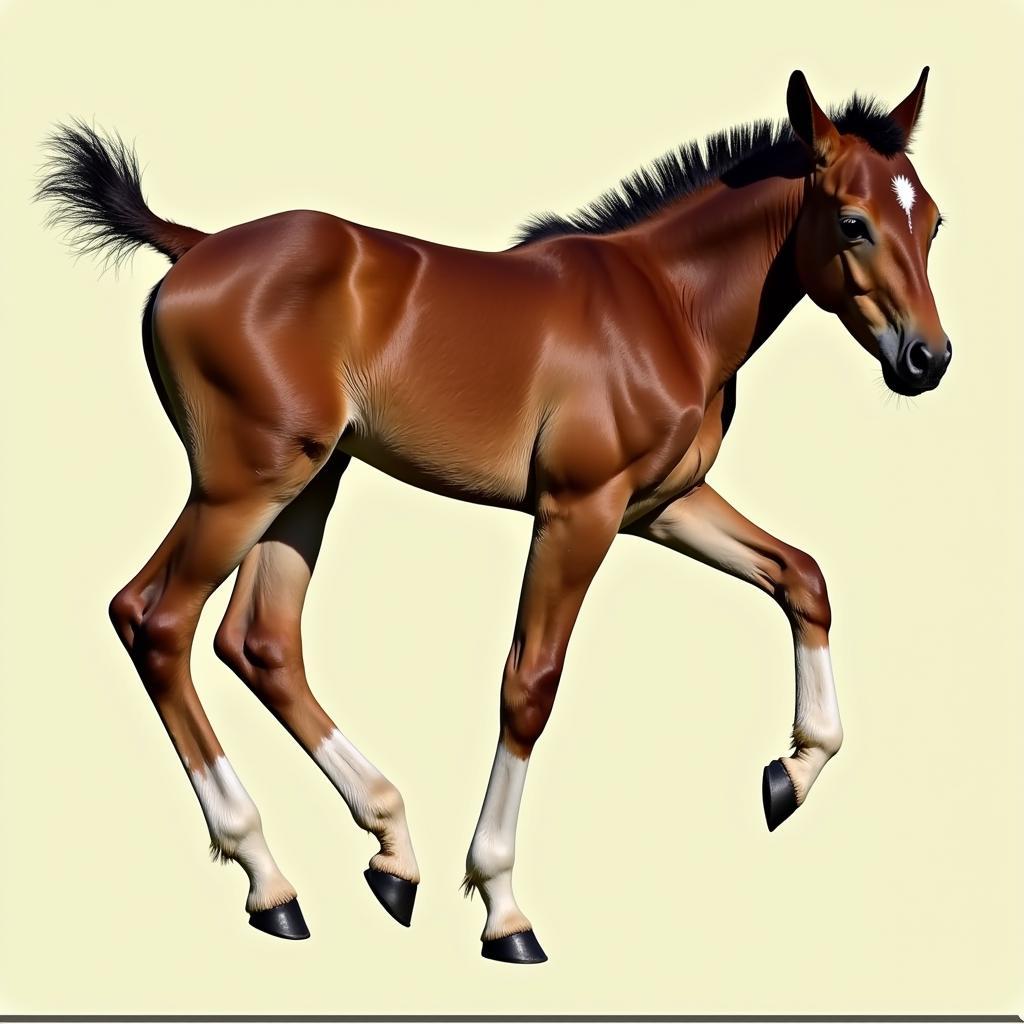Angular limb deformity in horses is a developmental orthopedic condition affecting the limbs of foals and young horses. This often manifests as a deviation in the limb’s normal straight alignment, potentially leading to lameness and long-term health issues. Understanding the causes, diagnosis, and treatment options is crucial for ensuring the well-being of affected horses.
What Causes Angular Limb Deformity in Horses?
Several factors can contribute to angular limb deformity. These include genetics, improper nutrition, and trauma. Specifically, imbalances in minerals like calcium and phosphorus during development can play a significant role.  Foal with Angular Limb Deformity Similarly, rapid growth spurts can sometimes outpace bone development, leading to deviations. In utero positioning can also be a contributing factor. Lastly, trauma to the growth plates can disrupt normal bone development.
Foal with Angular Limb Deformity Similarly, rapid growth spurts can sometimes outpace bone development, leading to deviations. In utero positioning can also be a contributing factor. Lastly, trauma to the growth plates can disrupt normal bone development.
Uneven growth rates between the medial and lateral aspects of the growth plates are the primary mechanism leading to the deformities. This can result in either valgus (outward deviation) or varus (inward deviation) deformities. The most commonly affected joints are the carpus (knee), fetlock, and tarsus (hock).
Recognizing the Signs: Valgus vs. Varus Deformities
Identifying the specific type of angular limb deformity is crucial for effective treatment. Valgus deformities present as an outward bowing of the limb, while varus deformities appear as an inward bowing. Both can significantly impact a horse’s movement and soundness. carpal valgus horse
“Early diagnosis is paramount,” says Dr. Amelia Hayes, DVM, an equine orthopedic specialist. “Addressing these deformities in their early stages offers the greatest chance for successful correction and a healthy outcome.”
Diagnosing Angular Limb Deformity in Horses
Diagnosing angular limb deformity usually involves a thorough physical examination, observing the horse’s stance and gait. Veterinarians also use radiographs (X-rays) to assess the severity of the deformity and to evaluate the growth plates. The degree of angulation can be measured from the radiographs, helping to determine the appropriate treatment plan.
Treatment Options: A Multifaceted Approach
Treatment options vary depending on the severity and location of the deformity. Mild cases may self-correct with controlled exercise and nutritional adjustments. More severe deformities may require interventions like corrective shoeing, casting, or surgery. Corrective shoeing aims to distribute weight and influence growth plate activity, while casting provides more rigid support and helps guide the limb into proper alignment. In some instances, surgical intervention may be necessary to correct severe deviations or address growth plate closure issues.
“Each case requires a tailored approach,” explains Dr. Hayes. “Factors like the horse’s age, breed, and overall health are all considered when developing a treatment plan.”
Managing Angular Limb Deformity: Long-Term Care
Even after successful treatment, ongoing monitoring is essential. Regular veterinary checkups, along with careful management of exercise and nutrition, are crucial for preventing recurrence or further complications. Owners should be vigilant for any signs of lameness or changes in gait. Early intervention can help minimize long-term effects and ensure the horse’s long-term soundness.
Conclusion: Ensuring a Healthy Future for Your Horse
Angular limb deformity in horses can be a concerning condition, but with early diagnosis and appropriate intervention, affected horses can often lead healthy and active lives. Understanding the causes, recognizing the signs, and seeking professional veterinary care are essential for managing this developmental issue and promoting a positive outcome for your equine companion. Proper management of angular limb deformity is crucial for ensuring a horse’s long-term soundness and well-being.
FAQs about Angular Limb Deformity in Horses
- What is the most common cause of angular limb deformity in horses? Nutritional imbalances during development, particularly involving calcium and phosphorus, are often the primary culprits.
- Can angular limb deformity be corrected? Yes, many cases, especially when diagnosed early, can be successfully corrected with appropriate treatment.
- What are the long-term consequences of untreated angular limb deformity? Untreated cases can lead to lameness, arthritis, and other complications later in life.
- How can I prevent angular limb deformity in my foal? Ensure your foal receives proper nutrition and avoid excessive exercise during growth periods.
- Is surgery always required for angular limb deformity? No, many cases can be managed with less invasive methods like corrective shoeing and casting.
- How long does it take for angular limb deformity to be corrected? The correction timeline varies depending on the severity and the chosen treatment method, ranging from weeks to months.
- What is the prognosis for horses with angular limb deformity? With proper management, many horses with angular limb deformity can achieve full soundness and have a normal athletic career.
You might also be interested in these related articles on our website: carpal valgus horse
For further assistance, please contact us at Phone: 0772127271, Email: [email protected], or visit our address: QGM2+WX2, Vị Trung, Vị Thuỷ, Hậu Giang, Việt Nam. We have a 24/7 customer service team.